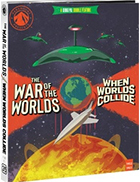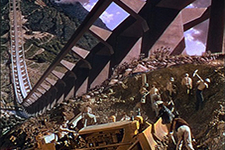| Director: Rudolph Maté | | Screenplay: Sidney Boehm (based on the novel by Edwin Balmer and Philip Wylie) | | Stars: Richard Derr (David Randall), Barbara Rush (Joyce Hendron), Peter Hanson (Dr. Tony Drake), John Hoyt (Sydney Stanton), Larry Keating (Dr. Cole Hendron), Judith Ames (Julie Cummings), Stephen Chase (Dean George Frye), Frank Cady (Harold Ferris), Hayden Rorke (Dr. Emery Bronson), Sandro Giglio (Dr. Ottinger) | | MPAA Rating: G | | Year of Release: 1951 | | Country: U.S. |  |
|  As Kim Newman points out in Apocalypse Movies, his encyclopedic study of end-of-the-world cinema, movies about the planet Earth being threatened from the heavens by rogue planets and giant chucks of space rock are nearly as old as the cinema itself. They began with The Comet (1910) and The Comet’s Comeback (1916), which were early attempts at creating synergy by riding the much-publicized wave of panic and awe that came with the passing of Halley’s comet. The first large-scale, major studio take on the subject was 1951’s doomsday epic When Worlds Collide, which was produced by George Pal (Destination Moon, The War of the Worlds). When Worlds Collide doesn’t pull any punches, immediately announcing its grandiosity by quoting from the Book of Genesis about God’s destruction of the sinful with a great flood. Rather than watery destruction, here we have fiery destruction in the form of a renegade sun and its orbiting planet that are on a sudden collision course with Earth. The pending end of the world is discovered by several scientists who take their findings to the United Nations, only to find that they are scorned and ridiculed as doomsayers trying to cash in on publicity. Undaunted, they enlist the aid of wealthy industrialists who have enough money to invest in a modern-day Noah’s ark, a rocket ship that will take a select number of people (just 40, in fact, along with some animals) off the Earth’s surface and attempt to land on the runaway planet that will just miss the Earth before the sun hits. Of course, this being 1951, it was still six years before a satellite would be put in orbit and more than a decade before humans would launch into space. Thus, the whole idea of launching to another planet is, in the movie’s terms, simply “theory.” Based on a 1933 novel by Edwin Balmer and Philip Wylie and adapted by Sidney Boehm, When Worlds Collide looks fairly hokey today, but beneath its dated Technicolor surface is an urge (however constrained) to truly explore human response to the end of the world. With eight months in the balance before Earth is decimated, the narrative focuses on a relatively small group of people involved with the building of the rocket ship. At first, it appears that the movie is going to take a generally positive slant by showing people working together so that some vestige of the human race can be preserved on another planet. But, once the clock starts ticking down on the final day, those who are being left behind rise up in revolt, suddenly wondering why it is they who are going to die. When Worlds Collide was celebrated at the time for its innovative special effects, winning an Academy Award that year for the effects work by Gordon Jennings, who won again a year later for The War of the Worlds (1953). The movie features not only the rocket ship with its long, roller-coaster-like launch track that goes up the side of a mountain, but a fairly extensive sequence of destruction when the rogue planet passes Earth’s atmosphere, causing earthquakes, volcanic eruptions, and tidal waves that swamp New York City. Viewed today, these effects are certainly less than convincing, as their origins as detailed models and painted backdrops are all too obvious, especially the grand finale that finds the humans on a paradisiacal planet presented as a truly awful matte painting. Yet, there is a real spark of creativity and visual ingenuity in the primitive effects, and it is not hard to see why audiences were wowed by their scope and grandeur. The central players are mostly stock characters, and the screenplay unwisely structures much of the drama around a melodramatic love triangle. One of the more interesting characters is Sydney Stanton (John Hoyt), a wheelchair-bound millionaire who funds much of the rocket construction out of purely selfish motives. The movie never allows him even a hint of redemption, and it is of little surprise that he is left behind in the end. Director Rudolph Maté, who worked as a cinematographer for such cinematic luminaries as Carl Theodor Dreyer, Fritz Lang, and Alfred Hitchcock before moving into the director’s chair, shows a limited ability to deal with complex human relationships, but a grandiose sense of spectacle and color. Viewed a half-century later, the movie’s ideological core is questionable, representative as it is of ’50s American culture. It is a bit unnerving, for instance, that the salvation of the human race conveniently includes the de facto removal of any possibilities of racial tensions on the new planet by ensuring that everyone deemed worthy of salvation in the rocket ship happens to be white. But, even if When Worlds Collide doesn’t play well politically or socially, it is still a fun, sometimes cheesy descent into apocalyptic nonsense. The science part of the science fiction is particularly inane (if a giant sun is approaching the Earth, how come it never gets any hotter?), but much of it still plays surprisingly well, although the most pleasurable way to watch it may be from a vantage point of ironic detachment, as past earnestness often makes for the best camp. | The War of the Worlds / When Worlds Collide “Paramount Presents” 4K UHD / Blu-ray Two-Disc Set | | | Aspect Ratio | 1.37:1 (both films) | | Audio | The War of the Worlds
English DTS-HD Master Audio 5.1 surroundFrench Dolby Digital 1.0 monauralWhen Worlds Collide
English DTS-HD Master Audio 5.1 surroundGerman Dolby Digital 1.0 monauralSpanish Dolby Digital 1.0 monauralFrench Dolby Digital 1.0 monaural | | Subtitles | The War of the Worlds: English, English SDH, French, German, Italian, Japanese, Spanish, Dutch / When Worlds Collide: English, English SDH, French, German, Japanese, Spanish | | Supplements | The War of the Worlds
Audio commentary by actors Ann Robinson and Gene BarryAudio commentary by film director Joe Dante, film historian Bob Burns, and Bill Warren, author of Keep Watching The Skies!“The Sky Is Falling: Making The War of the Worlds” documentary“H.G. Wells: The Father of Science Fiction” featuretteThe Mercury Theatre On The Air presents “The War of the Worlds” radio broadcastOriginal theatrical trailerWhen Worlds Collide
Original theatrical trailer | | Distributor | Paramount Home Entertainment | | Release Date | September 27, 2022 | | | COMMENTS | | The War of the Worlds and When Worlds Collide are each housed on a separate disc in Paramount’s “George Pal Double Feature” set, with the former debuting on 4K UHD and the latter on Blu-ray. The 4K presentation of The War of the Worlds derives from the same 2018 restoration that was used for The Criterion Collector’s Blu-ray release a few years ago, in which the original Technicolor three-strip negatives were scanned in 4K and restored. Criterion’s Blu-ray was a striking improvement over Paramount’s 2005 DVD, and this 2160p/Dolby Vision UHD presentation give us an even more vivid reproduction of the ’50s Technicolor experience. Colors are slightly brighter and more saturated, and visual detail and texture gets a boost. Like the Criterion disc, the image is free of dust, scratches, and wear (some shots are noticeably softer than others, but this is inherent to the original elements). Note has to be made, though, of a major, major error in one of the film’s first shots where the planet Mars looks decidedly blue, rather than predominantly red as it was intended. This appears to be an error in the original scan and one that Criterion corrected for their release, but was inexplicably left on Paramount’s. As for When Worlds Collide, its high-definition presentation appears to have come from the same source as the 2020 region-free Imprint Blu-ray, but from what I have seen in comparing this disc with screen caps I’ve seen online from Imprint’s, the two transfers look quite different. Paramount’s transfer is somewhat duller than Imprint’s, with whites leaning a tad yellowish while Imprint’s are bright and slightly bluish. Color overall appears a bit faded and not at all as vibrant as you might expect from a ’50s Technicolor film. Perhaps this was a purposeful choice in the color grading (maybe to make it look a bit more realistic?), but it seems odd. In terms soundtracks, both films sport newly prepared 5.1-channel mixes presented in DTS-HD Master Audio. For The War of the Worlds, master sound designer Ben Burtt (Star Wars, WALL•E) was brought in to create the six-channel mix using the preservation magnetic tracks, several single-strip monaural music cues, and archival sound effects from Burtt’s own library. The result is quite impressive, especially given that Burtt had to essentially rebuild parts of the soundtrack. The surround effects really work, with good space and directionality, which heightened the Martian invaders’ otherworldly noises and produces some startling moments (when the meteor started “unscrewing,” the sound is located firmly over your left shoulder and made me jump). There is also a great deal more weight to the track, with the newly added LFE channel giving the explosions, crashing buildings, and atomic detonation some real power. The six-channel soundtrack for When Worlds Collide also sounds very good, with some nice directionality and depth, especially in the destruction sequences in the film’s second half that are given a solid boost with the LFE track. On The War of the Worlds, all of the supplements date back to Paramount’s 2005 DVD. There are two audio commentaries: The first, by actors Gene Barry and Ann Robinson, is definitely the lesser of the two, although it is still worth a spin. The second track, by fan/film director Joe Dante (Gremlins), film historian Bob Burns, and sci-fi expert Bill Warren (author of Keep Watching the Skies!, one of the definitive books on science fiction), is definitely worth a listen, as they offer all kinds of interesting insight into the film and the lore surrounding it. More information about the film can be found in “The Sky is Falling: Making The War of the Worlds,” a first-rate 30-minute retrospective featurette that features interviews with a wide range of participants, from actor Gene Barry, to assistant director Mickey Moore, to special effects guru Al Nozaki (who, having passed away, is seen only in archival video footage). Some of the highlights include Ray Harryhausen’s stop-motion animation tests for the Martians, some hilarious stories about the creation of the Martian suit, and a bit about how George Pal used to always slip Woody Woodpecker into his movies (yes, he’s in The War of the Worlds). The shorter featurette “H.G. Wells: The Father of Science Fiction,” which runs about 10 minutes, gives a brief rundown of the life of the great sci-fi innovator. A nice inclusion is the complete Mercury Theatre radio broadcast of The War of the Worlds, which starred Orson Welles and famously sent some people running for the hills when they mistook it for the real deal. There is also an original theatrical trailer. On the When Worlds Collide disc, the only supplement is a trailer, which is a real disappointment given that the Imprint Blu-ray was stacked with material. |
Copyright © 2022 James Kendrick Thoughts? E-mail James Kendrick All images copyright © Paramount Home Entertainment |



 (2.5)
(2.5)

